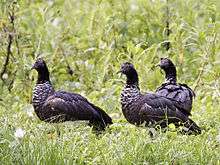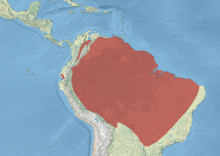Horned screamer
The horned screamer (Anhima cornuta) is a member of a small family of birds, the Anhimidae, which occurs in wetlands of tropical South America. There are three screamer species, the other two being the southern screamer and the northern screamer in the genus Chauna. They are related to the ducks, geese and swans, which are in the family Anatidae, but have bills looking more like those of game birds.
| Horned screamer | |
|---|---|
 | |
| Three in Manu National Park, Peru | |
| Scientific classification | |
| Kingdom: | Animalia |
| Phylum: | Chordata |
| Class: | Aves |
| Order: | Anseriformes |
| Family: | Anhimidae |
| Genus: | Anhima Brisson, 1760 |
| Species: | A. cornuta |
| Binomial name | |
| Anhima cornuta (Linnaeus, 1766) | |
 | |
| Distribution map | |
| Synonyms | |
|
Palamedea cornuta Linnaeus, 1766 | |
Taxonomy
Already known in the 17th century[2], the horned screamer was described in 1766 by the Swedish naturalist Carl Linnaeus in the twelfth edition of his Systema Naturae. He introduced the binomial name Palamedea cornuta.[3] The horned screamer is now the only species placed in the genus Anhima that was introduced by the French zoologist Mathurin Jacques Brisson in 1760.[4][5] The specific epithet cornuta is the Latin word for "horned".[6] The German naturalist Georg Marcgrave had used the Latin name Anhima in 1648 for the horned screamer in his Historia naturalis Brasiliae.[7] The name was from the word for the bird in the Tupi language of South America.[8]
Description
The horned screamer is a massive 84–95 cm (33–37.5 in) long, 3.5 kg (7.7 lb) bird, with a small chicken-like bill. The upperparts, head, and breast are black, with white speckles on the crown, throat and wing coverts. There is a long spiny structure projecting forward from the crown. This structure is unique among birds and is not derived from a feather but is a cornified structure that is loosely attached to the skull and grows continuously while often breaking at its tip.[9] This gives this species its name. It has very long and lanky legs and three large toes in each. The belly and under wing coverts are white. It has two sharp spurs on its wings and feet which are only partially webbed.
The horned screamer's call, as its name suggests, is a very loud echoing sound.[10] It is called "El Clon-Clon" in Ecuador because of this peculiar feature.
Distribution, habitat and behavior
The horned screamer is found in lowlands from Colombia, Venezuela, Brazil, Bolivia, Peru, Ecuador, French Guiana, and Guyana.[11][12] It is now extinct in Trinidad and Tobago and Suriname.[11] Despite having declined locally, it remains widespread and is fairly common overall. Its range in Brazil appears to have expanded in recent years.
It lives in well-vegetated marshes and feeds on water plants. Its nest is a large pile of floating vegetation anchored in shallow water. Three olive-brown eggs are laid, and the young, like those of most Anseriformes, can run as soon as they are hatched.
As a symbol
The horned screamer is the official bird of the Department of Arauca and the Municipality of Arauca in Colombia and it is also a symbol in the National Reserve of Churute in Ecuador. The department and its capital are named after the bird, which is called Arauco in Spanish.
Footnotes
- BirdLife International (2012). "Anhima cornuta". IUCN Red List of Threatened Species. 2012. Retrieved 26 November 2013.CS1 maint: ref=harv (link)
- Grew, Nehemiah (1681). Rarities belonging to the Royal Society, p.65.
- Linnaeus, Carl (1766). Systema naturae : per regna tria natura, secundum classes, ordines, genera, species, cum characteribus, differentiis, synonymis, locis (in Latin). Volume 1, Part 1 (12th ed.). Holmiae (Stockholm): Laurentii Salvii. p. 232.
- Brisson, Mathurin Jacques (1760). Ornithologie, ou, Méthode Contenant la Division des Oiseaux en Ordres, Sections, Genres, Especes & leurs Variétés (in French and Latin). Paris: Jean-Baptiste Bauche. Vol. 1, p. 48, Vol. 5, p. 518.
- Gill, Frank; Donsker, David, eds. (2019). "Screamers, ducks, geese, swans". World Bird List Version 9.1. International Ornithologists' Union. Retrieved 9 April 2019.
- Jobling, J.A. (2019). del Hoyo, J.; Elliott, A.; Sargatal, J.; Christie, D.A.; de Juana, E. (eds.). "Key to Scientific Names in Ornithology". Handbook of the Birds of the World Alive. Lynx Edicions. Retrieved 9 April 2019.
- Marcgrave, Georg (1648). Historia naturalis Brasiliae (in Latin). Liber Quintus: Qui agit de Avibus. Lugdun and Batavorum (London and Leiden): Franciscum Hackium and Elzevirium. p. 215.
- Jobling, J.A. (2019). del Hoyo, J.; Elliott, A.; Sargatal, J.; Christie, D.A.; de Juana, E. (eds.). "Key to Scientific Names in Ornithology". Handbook of the Birds of the World Alive. Lynx Edicions. Retrieved 9 April 2019.
- Stettenheim, Peter R. (2000). "The Integumentary Morphology of Modern Birds—An Overview". American Zoologist. 40 (4): 461–477. doi:10.1093/icb/40.4.461.
- Lodge Amazon (2015-03-21), Horned Screamers Loud, retrieved 2018-11-19
- IUCN (2009)
- Clements, J. (2007)
- "camaratiete.com". Archived from the original on 2008-03-18. Retrieved 2006-10-01.
References
- Clements, James, (2007) The Clements Checklist of the Birds of the World, Cornell University Press, Ithaca
- Hilty, Steven, L. (2003) Birds of Venezuela, ISBN 0-7136-6418-5
External links
| Wikimedia Commons has media related to Anhima cornuta. |
- Horned Screamer at Internet Bird Collection.
